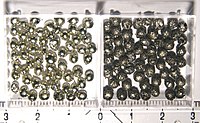
Photo from wikipedia
We report on the optoelectronic properties of a recently discovered nanotubular phase of misfit-layered calcium cobalt oxide, CaCoO2–CoO2. Individual nanotubes are investigated by spatially resolved electron energy-loss spectroscopy experiments performed… Click to show full abstract
We report on the optoelectronic properties of a recently discovered nanotubular phase of misfit-layered calcium cobalt oxide, CaCoO2–CoO2. Individual nanotubes are investigated by spatially resolved electron energy-loss spectroscopy experiments performed in a transmission electron microscope, and complementary first-principles, time-dependent hybrid density-functional theory calculations are performed to elucidate the electronic structure and optical spectra. We find that the band gap is independent of the geometry of the nanotubes, and experimental and calculated results independently confirm an optical gap of 1.9–2.1 eV for the CaCoO2–CoO2 nanotubes. The time-dependent hybrid density-functional theory calculations also suggest the existence of strongly bound intralayer excitons (up to 0.5 eV binding energy), which could allow for optoelectronic applications of these nanotubes at near-infrared to visible (∼1.5–2 eV) wavelengths.We report on the optoelectronic properties of a recently discovered nanotubular phase of misfit-layered calcium cobalt oxide, CaCoO2–CoO2. Individual nanotubes are investigated by spatially resolved electron energy-loss spectroscopy experiments performed in a transmission electron microscope, and complementary first-principles, time-dependent hybrid density-functional theory calculations are performed to elucidate the electronic structure and optical spectra. We find that the band gap is independent of the geometry of the nanotubes, and experimental and calculated results independently confirm an optical gap of 1.9–2.1 eV for the CaCoO2–CoO2 nanotubes. The time-dependent hybrid density-functional theory calculations also suggest the existence of strongly bound intralayer excitons (up to 0.5 eV binding energy), which could allow for optoelectronic applications of these nanotubes at near-infrared to visible (∼1.5–2 eV) wavelengths.
Journal Title: Applied Physics Letters
Year Published: 2018
Link to full text (if available)
Share on Social Media: Sign Up to like & get
recommendations!